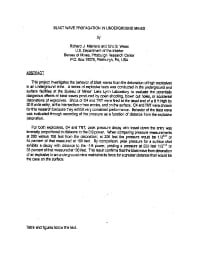Mining Publication: Blast Wave Propagation in Underground Mines
Original creation date: February 1995
Authors: RJ Mainiero, ES Weiss
Proc 11th Symposium on Explosives and Blasting Research. Nashville, TN, 1995 Feb; :47-61
This project investigates the behavior of blast waves from the detonation of high explosives in an underground mine. A series of explosive tests was conducted in the underground and surface facilities at the Bureau of Mines' Lake Lynn Laboratory to evaluate the potentially dangerous effects of blast waves produced by open shooting, blown out holes, or accidental detonations of explosives. Shots of C4 and TNT were fired at the dead end of a 6 ft high by 20 ft wide entry, at the intersection of two entries, and on the surface. C4 and TNT were chosen for this research because they exhibit very consistent performance. Behavior of the blast wave was evaluated through recording of the pressure as a function of distance from the explosive detonation.
For both explosives, C4 and TNT, peak pressure decay with travel down the entry was inversely proportional to distance to the 0.9 power. When comparing pressure measurements at 200 versus 100 feet from the detonation; at 200 feet the pressure would be 1/20.9 or 54 percent of that measured at 100 feet. By comparison, peak pressure for a surface shot exhibits a decay with distance to the -1.6 power, yielding a pressure at 200 feet 1/21.6 or 33 percent of that measured at 100 feet. This result confirms that the blast wave from detonation of an explosive in an underground mine maintains its force for a greater distance than would be the case on the surface.

Proc 11th Symposium on Explosives and Blasting Research. Nashville, TN, 1995 Feb; :47-61
- A Century of Bureau of Mines/NIOSH Explosives Research
- Explosion Pressure Design Criteria for New Seals in U.S. Coal Mines
- A Gas Pressure-Based Drift Round Blast Design Methodology
- In-depth Survey Report: Control Technology for Environmental Enclosures - The Effect of Wind Speed Upon Aerosol Penetration Into an Enclosure at Clean Air Filter, Defiance, IA
- Low Temperature Limits for Mixing Recycled Oil, Diesel Fuel, and Ammonium Nitrate to Make ANFO-Type Blasting Agents
- Methane Diffusion Parameters for Sized Coal Particles: A Measuring Apparatus and Some Preliminary Results
- The NIOSH Shield Hydraulics Inspection and Evaluation of Leg Data (Shield) Computer Program
- Technology News 522 - Blast Area Security: Flyrock Safety
- Toolbox Training on Flyrock Awareness
- Tying Acceleration and GPS Location Information Together To Create a Mine Management Tool